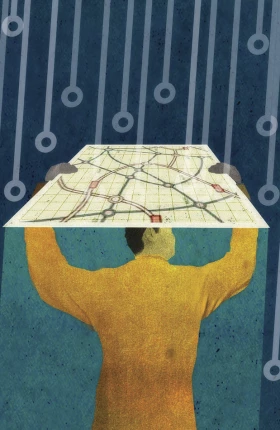Auto insurers are basking in a false sense of security, seemingly oblivious to the impending decline in market size and the threat of new entrants. The sector is ripe for disruption: the value of insurers’ proprietary data and traditional expertise is diminishing, and other players are emerging with the data, analytics, and customer access needed to attack the value chain. In light of the combined threat of these dynamics, incremental change is not an option. Insurers must adapt.
The Boston Consulting Group and Morgan Stanley Research conducted 45 interviews with senior executives of insurers, OEMs, and technology providers around the world. In addition, we surveyed drivers and auto insurance customers in 11 countries. Finally, we modeled the impact of technology change and shared vehicles on the industry from 2015 through 2040.
Although specific dynamics will vary by market, our research yielded several key conclusions:
- Shrinking Mature Markets. The auto insurance market could decline to 40% to 50% of its current size by 2030, and even to 20% to 30% by 2040 in certain mature markets.
- An Even Greater Reduction in Personal Lines. We expect the proportion of personal lines to commercial lines to shift from about 80:20 in 2015 to 50:50 by 2030 and 30:70 by 2040. In mature markets, this means a 65% reduction of the personal auto insurance market by 2030.
- Rise of Nontraditional Players. The incumbent motor insurance model is likely to be heavily disrupted by new players with access to proprietary driver data, superior analytics capabilities, and direct customer access. For instance, shared-mobility players not only will own the data but are likely to perform their own analytics, leaving insurers struggling for insight into the growing commercial-line market. Furthermore, we see a credible threat that tech giants, OEMs, and, to a lesser extent, telcos could corner a significant (and profitable) share of the remaining personal-line market. Our consumer survey supports this potential outcome, showing that nearly 50% of today’s young driver population is prepared to purchase motor insurance from nontraditional players.
- Higher Growth in Emerging Markets. Insurance premiums in emerging markets will keep growing, predominantly driven by increasing vehicle volumes and miles driven. China, which today represents approximately 13% of the global motor market, will capture some 20% of it by 2025.
Insurers must respond quickly to defend their turf against these combined threats. We recommend a fundamental rethinking of all aspects of the operating model—including product and business mix, underwriting capabilities, distribution channels, cost structure, and acquisition strategy. Broadly, we see three nonexclusive strategic plays:
- Digital Play—leveraging technology throughout the value chain to exchange data and engage with consumers, optimize the cost of risk, and achieve superior cost efficiency
- Partnership Play—turning to strategic partners (most likely, OEMs, new mobility players, telematics manufacturers, and telcos) to secure access to data and customers or to complement coverage-related services, so as to keep increasing revenue within the motor insurance value chain and defend against potential disruptors
- Adjacency Play—expanding into mobility-related adjacencies (possibly including car safety features, car repairs, services related to roadside assistance, new mobility solutions, and products covering new risks such as cyber) in order to increase consumer engagement, collect more data, replace lost revenue, and fuel future growth
The relevant strategic choices and timing of execution will depend on each insurer’s size and business mix. For example, multinational insurers are in a better position to form partnerships with disruptors such as OEMs and tech giants. Insurers with a younger, more urban customer base should consider diversifying even more rapidly. There is no standardized approach, and the path to the future state is unlikely to be linear.





